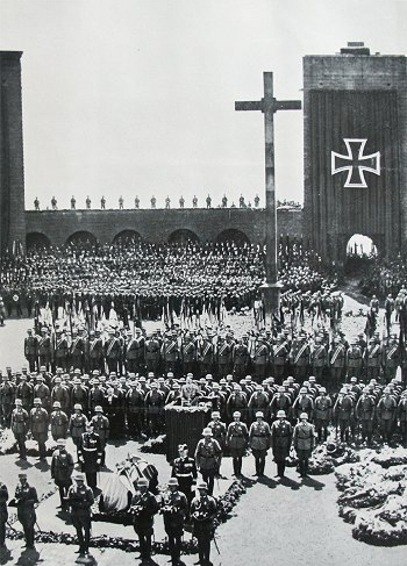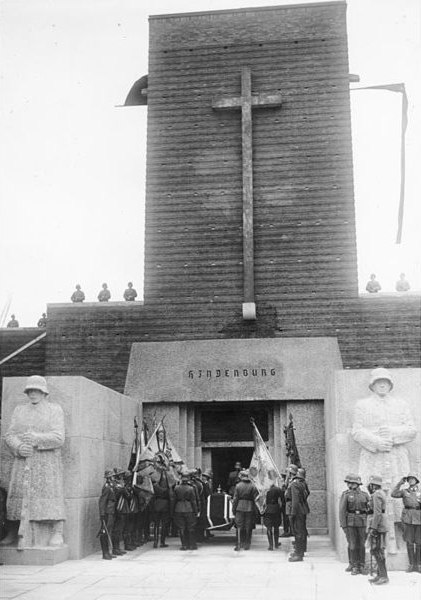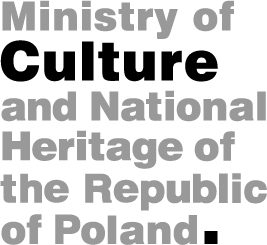|
|
Klemens Frenszkowski in his memoir entitled Pamiętnik Warmiaka (introduction and preparation by Jan Chłosta, Olsztyn 2006) writes about his impressions of the ceremonial funeral of Marshal Paul von Hindenburg in the following way: "During my then stay at the family house in August 1934, there were events announced, related to the transportation of the remains of the former Field Marshal and the President of the Reich – Hindenburg, who had died in his mansion of Neudeck, now Ogrodzieniec, near the Town of Iława in East Prussia, where a monument-mausoleum was erected to him, to commemorate a battle from 1914, called The Battle of Tannenberg. The monument was composed of several towers, named after field marshals from the First World War. They were joined by a tall wall, accommodating rooms where keepsakes from the war were stored: regimental banners, arms and the like. The ashes of the marshals were supposed to be laid under each of the towers, named after each marshal. Inside the complex, was a spacious yard with the tomb of unknown soldiers in the centre. The tomb hosted the remains of 20 soldiers who had died in the battle mentioned above. I decided to go there on the day of the funeral ceremony to take a closer look at it. Despite the fact that Hindenburg was only a marionette in Hitler's hands after he had gained power, as well as the fact that Hindenburg was actually cheated on his deathbed, Hitler gave this ceremony the character of a patriotic manifestation, meant to show the gratitude of the German nation to the marshal and president for his merit. Consequently, the entire propaganda apparatus was employed. Spending huge sums of money, the Nazis tried to draw masses of people to the town of Olsztynek on that day. Additionally, Hitler tried to use the popularity which Hindenburg enjoyed for his own purposes. Regular train services between Olsztyn and Olsztynek did not function because the tracks were packed with special transports from Germany. Well, numerous delegations and excursions arrived from all corners of Germany. It was estimated that there were almost 200 thousand people around the monument on that day. I got there by taxi, which drove me to Olsztynek and, next, I walked to the site from there. On my way, I met groups of people going in the same direction. There were still a few hours before the beginning of the ceremony. Walking across the fields, I ran across two overgrown places with mass tombs. Probably, they were the graves of Russian soldiers because a cemetery of fallen German soldiers was farther on and was rather better kept. The coffin with Hindenburg's body was already inside the mausoleum. It had been transported there early in the morning, when the site had still been empty. Nobody was admitted inside. There was only an honorary company and invited guests there, including Nazi dignitaries from the higher ranks and representatives from foreign countries. Their cars drove as far as the main gate and drove to the side after the passengers got out. As for other cars, there was a large field in the distance which they could use for parking. The people gathered surrounded the monument where loudspeakers were placed at a certain distance from each other. It was about one hour before the ceremony when the first cars with Nazi dignitaries and representatives of foreign countries arrived. Some of the cars were drophead coupés because the weather was nice on that day. Crowds of cheering people stood along the two sides of the road from Olsztynek. From time to time, someone would shout "Der Führer kommt" (The Leader is coming) but, the Führer was still not there. Göring, Hess, Rosenberg, Ribbentrop and others had already arrived. Even Prinz Auwi had appeared in a Nazi uniform (prince August, a son of Emperor Wilhelm II, who joined the Nazi party, and was called Prinz Auwi). After the arrival of Goebels and Göring, one could have expected Hitler. However, both his fans and the participants of the funeral ceremony were disappointed. It turned out that Hitler was already inside, unnoticed by anyone. How he had managed to get in there, nobody knew. No-one had noticed him go in. People speculated about it widely. I believe that he came in a covered car so nobody saw him. Probably, he was not sure about his own body guards. The funeral speech was delivered by Hitler himself. Finishing he said, pointing at the coffin "Gehn ein in Wallhall" ("Enter Valhalla"). Next, the coffin was taken to a room on the ground floor of the tower, the main entrance, first on the right. After that, the announcement said a soldier’s song "Ich hat einen Kameraden" (I had a comrade), which came out rather pale. I moved discretely back at that time to avoid the possible consequences for not holding my hand up during the singing. After the ceremony, the entrance to the mausoleum was opened to the public. I also used the opportunity and looked at the building and the collection from the First World War. The door to the chamber with the coffin accommodating Hindenburg's corpse remained open, so the coffin was visible from the outside. Long rows of wreaths lay in the courtyard, including a wreath from the Polish government". Translated by Marzena Beata Guzowska
|

Marshal von Hindenburg's coffin in the courtyard of the monument Tannenberg-Denkmal, before it's placing into a crypt. 
Hindenburg's tower, where the coffin with his corpse was placed, 02.10.1935. Four-metre high stone effigies of soldiers, made in the yeas 1935-1936 by the German sculptor Paul Bronisch, stand at the sides of the crypt. |
|||
| |||||
